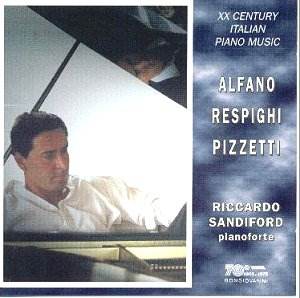Collection: 20th Century Italian Piano
Music
Ottorino RESPIGHI (1879-1936)
Valse; Canone; Notturno; Minuetto; Studio;
Intermezzo.
Franco ALFANO (1875-1954)
Four pieces: Mazurka; Romanzetta; Fable; and Causerie.
Nostalgie.
Ildebrando PIZZETTI (1880-1968)
Sogno; Canti di Ricordanza Nos.1 - 4
Poemetto Romantico: Appassionato; Intermezzo; Triste
 Riccardo Sandiford
(piano)
Riccardo Sandiford
(piano)
 BONGIOVANNI GB 5099-2
[69:06]
BONGIOVANNI GB 5099-2
[69:06]
Crotchet

Think of Italian music and think of opera. But a small group of musicians
sought to free themselves from the shackles of this exclusivity and turn
to other musical forms. A group of musicians, born around the same time in
the 1880s broke away from operatic conventions and explored other genres.
They were: Franco Alfano, Ottorino Respighi, Ildebrando Pizzetti, Gian Francesco
Malipiero (1882-1973) and Alfredo Casella (1883-1947). They carried on the
pioneering work of Respighi's teacher Giuseppe Martucci (1856-1909). This
CD includes piano music by three of the "Eighties Generation".
It is interesting to note that their music alternates between a longing for
innovation and a conscious retrieval of the past.
The best-known of the three composers is Ottorino Respighi, composer of
Fountains of Rome and Pines of Rome. His compositions
for piano are small in number. The six pieces on this album are colourful
and full of charm. The opening florid Valse caressante caresses
the ear with its easy-going salon style that hides some complexity of texture.
It is intimate, relaxed and dreamily nostalgic. Canone nicely
balances romance with classical formality. The standout piece is
Nottorno that has a haunting, almost hypnotic limpid beauty
with its concentric ripples and gentle introspection. Technically, it
demonstrates that Respighi was keeping abreast of the times because of its
effects, its fleeting reflections, refracting harmonies, and transparent
colours, rather like Debussy and Ravel were using during the same period.
Equally memorable and enchanting, is the beautifully decorated
Intermezzo an unashamedly romantic piece with a gorgeous melody
of nostalgic yearning. Minuetto has grace and charm while
Studio demands great agility and a clean touch to surmount
its tricky 12/8 rhythm pattern.
Franco Alfano is remembered mostly for having completed Puccini's
Turandot. His refined piano music shows influences of Debussy and
Strauss. His Four Pieces were written when he was 24. His
Mazurka is intimate and informal yet frolicsome and capricious
too - one notices snatches of Scotch snap and polonaise as well as the rhythms
of the mazurka - there is a distinct feeling of extemporisation. The
Romanzetta is a delightful coyly romantic piece reminiscent
of Schumann - so, too, is Fable but this faster-moving, more
complex piece is altogether more proud and virile. With
Causerie, Alfano moves away from dreamy romanticism and gives
us a sophisticated, witty piece that seems to imitate the light babble of
a chat. Nostalgie composed in 1918 is even more progressive
- Alfano takes two well-known songs from his beloved Naples and breaks them
up in chiaroscuro writing that also exploits a modal scale with Spanish
colouring.
Pizzetti's Sogno was written when he was a student of 18. His
subtitle for the work is "Lirica per pianoforte" and it alludes to his interest
in opera and song. Its sentimental ballad-like sweetness is tempered by some
robust heroic and tragic writing. Poemetto
Romantico (1909) is imbued with feelings of nostalgia and a
worrying awareness of change and crisis at the turn of the century. As the
author of the erudite booklet notes, Francesco Ermini Polacci suggests, the
work seems to be offering "a sort of sombre farewell to Romanticism" - most
apparent in the beautiful meditative Triste.
Appassionato is elegant, discreet, introspective, sometimes
passionate. Intermezzo is lovely - calm and relaxed, almost
hymn-like. Pizzetti's Canti di Ricordanza were written during
the horrors of world War II. They bear the anxieties of the times with some
dejected and chaotic military figures but there are also pages of peace and
calm. Pizzetti often uses bell-like figures to banish his ghosts and draws
on the stability of Gregorian chant in a desire for purity and spirituality.
Sandiford's polished playing and considerable style and finesse brings out
the delicate beauty of these pieces as well as plumbing their emotional depths.
For the adventurous this is a very rewarding collection which I recommend
most heartily.
Ian Lace

